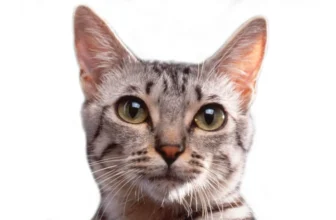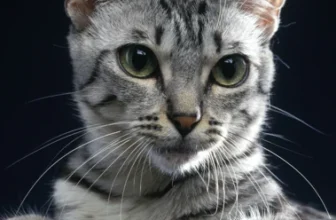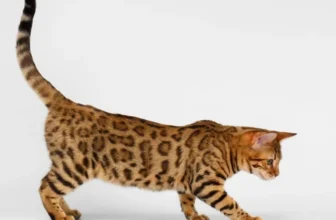As a proud California Spangled cat owner, the prospect of welcoming a new litter of kittens into the world can be both exciting and nerve-wracking. The birthing process can be unpredictable, and it’s essential to know what to expect to ensure a safe delivery for both the mother and her offspring. In this comprehensive guide, we’ll take a step-by-step journey through the birthing process of California Spangled cats. From signs of labor to caring for newborns and their mother, we’ll provide valuable insights to prepare you for this magical experience. So sit back, relax, and let’s delve into the world of California Spangled cat birthing!
Signs of Labor

As the due date of your California Spangled cat approaches, it’s important to be aware of the various signs of labor that your cat may exhibit. Knowing what to expect and being prepared can help ease your worries and ensure a smooth birthing process. Keep an eye out for the following signs indicating that labor may begin: decreased appetite and activity levels, nesting behavior and vocalization, temperature drop, and bloody discharge. If you’re unsure about any of these signs, it’s essential to have a veterinarian examine your cat for further guidance.
Decreased appetite and activity levels
During the birthing process of California Spangled cats, you should keep an eye on your cat for any unusual changes in her behavior, especially her appetite and activity levels. Usually, before delivery, a decrease in her appetite and activity levels will occur, signaling that the birthing process is about to start. It’s essential to note that a loss of appetite may not necessarily mean that your cat isn’t well, and it’s quite normal for cats to have reduced eating habits during their pregnancies. If you are concerned about your feline not eating at all, provide her with small amounts of food at regular intervals. Make sure that she drinks enough water and consult with your veterinarian if you are worried. Proper monitoring and care are key to ensuring that your cat and her kittens are healthy throughout the birthing process.
As the due date approaches, you may observe that your cat’s activity levels have decreased as well. Your cat will require plenty of rest to prepare for the labor and delivery stages. Ideally, provide a quiet, warm, and comfortable space for your cat to rest in. This will help ensure she feels secure and relaxed, ultimately minimizing the stress she may feel during delivery. Pet owners should be patient with their cats, giving them the time they need to rest and prepare for birth.
If you think that your cat is not nesting or showing other signs of labor, this might be a sign of infertility. In this case, it is recommended to take your cat to the veterinarian to evaluate the situation and provide the necessary information about infertility in cats. Understanding the signs of infertility will give you the knowledge to prevent major complications. Learn more about infertility and how to overcome these complications in California Spangled cats.
Nesting behavior and vocalization
During the birthing process of California Spangled cats, nesting behavior and vocalization are some prominent signs that you can observe. A pregnant cat may start to decorate her chosen birthing area with soft materials such as blankets, towels, or even clothes. This indicates that she is preparing to give birth and wants a cozy and comfortable area for her newborn kittens.
Vocalization is another sign that indicates the beginning of labor. Your cat may start to get restless or anxious and may continuously meow or purr more than usual. This is her way of showing that she is in discomfort and needs attention. As labor progresses, the vocalization can become louder and more frequent.
If you see your cat exhibiting these behaviors, it is advisable not to disturb her too much as she needs time and space to feel relaxed and comfortable. You can, however, observe her from a distance to ensure that everything is going well.
If you are a new breeder or owner and want to learn more about the breeding process of California Spangled cats, you can visit cali-spangled-cat-mating-guide to get a step-by-step guide on how to breed your cats successfully. Knowing the breeding process and different signs of successful mating, such as those discussed in 5-signs-successful-mating-california-spangled-cats can help you prepare well in advance.
Apart from proper breeding, it is also important to take care of your cat’s nutrition, health, and age before allowing her to conceive. You can read more about preparing California Spangled cat breeding tips and tricks to get an idea of what you need to do.
It is well-known that genetics play a vital role in a cat’s health and behavior. Understanding genetics of California Spangled cats can help you produce healthier offspring with desirable traits.
Lastly, knowing the optimal breeding age of California Spangled cats can help you breed them effectively and ensure their health and wellbeing. With proper preparation and care, you can rest assured that your cat’s nesting behavior and vocalization during labor will result in a healthy offspring fit for any loving home.
Temperature drop
One of the most reliable signs of an impending delivery in California Spangled cats is a drop in body temperature. Normally, a cat’s body temperature is around 101 to 102.5 degrees Fahrenheit. However, when the birthing process is about to start, the temperature can drop to as low as 99 degrees Fahrenheit. This drop in temperature can be an indication that labor will begin within the next 24 hours.
To accurately monitor the cat’s temperature, you can use a digital thermometer specifically designed for cats. You can take the cat’s temperature rectally, and it is essential to use a thermometer that is intended for this purpose.
It is essential to keep in mind that not all cats show a temperature drop before birth. Some cats may go into labor without any noticeable temperature change. It is crucial to look out for other indicators of labor as well, such as behavioral changes and nesting activities.
Here’s a summary of what to expect from the temperature drop in California Spangled cats before labor begins:
| What to expect | Normal range | Before Labor |
|---|---|---|
| Body Temperature (°F) | 101 to 102.5 | 99 |
Remember, each cat is unique, and it is essential to observe your California Spangled cat closely during pregnancy to identify any changes in behavior or other indicators of impending labor.
Bloody discharge
As labor approaches, a pregnant California Spangled cat may experience a bloody discharge. This is a sign that the cervix is beginning to dilate and the cat’s body is preparing for delivery. It’s important for cat owners to monitor their pet’s discharge and consult with a veterinarian if they notice anything unusual.
What is the Bloody Discharge?
The bloody discharge is a mixture of blood, mucus, and other fluids that are released from the cat’s vagina. It is usually dark red or brown in color and may have a stringy or gelatinous texture. This discharge is also known as “bloody show” or “mucous plug”.
When Does the Bloody Discharge Occur?
The bloody discharge can occur at any time during the later stages of pregnancy but is most commonly seen in the days leading up to labor. This is a sign that the cervical plug, which seals the uterus and keeps bacteria out, is starting to come loose. As a result, the blood vessels around the cervix may rupture, causing the discharge.
What to Do if Your Cat Has a Bloody Discharge
If you notice a bloody discharge from your cat, it’s important to monitor her closely. Look for signs of labor, such as contractions, nesting behavior, and vocalization. If your cat is not showing any other signs of labor, it’s best to contact your veterinarian for guidance and advice.
In rare cases, a bloody discharge may indicate a medical emergency, such as a placental abruption or fetal distress. This is why it’s important to seek medical attention if you notice anything unusual about your cat’s discharge.
A bloody discharge is a common sign of labor in California Spangled cats. It’s important for cat owners to be aware of this and to monitor their pets closely for any other signs of labor. If you notice anything unusual about your cat’s discharge, contact your veterinarian for guidance and advice.
Labor and Delivery

The birthing process for California Spangled cats can be an exciting yet nerve-wracking experience. Once you have identified the signs of labor, it’s time to prepare for the actual delivery. The labor and delivery stages can be divided into three parts, each serving a unique purpose in the arrival of the newborn kittens. Let’s explore these stages in more detail to help ease any concerns and ensure you are prepared for the big moment.
Stage One – Contractions Begin
During Stage One of labor, the California Spangled cat will begin to experience contractions, which indicate that the birthing process is starting. This stage can last anywhere from a few hours to a full day, depending on the number of kittens the cat is carrying and other factors.
The Signs:
During this stage, the cat may show signs of discomfort, restlessness, or nervousness. She may also begin to pace, groom herself excessively, or pant heavily. As an assistant, it is essential to keep a close eye on the cat and monitor her for any signs of distress.
The Contractions:
As the cat’s labor progresses, her contractions will become more frequent and intense. These contractions are the result of the uterus contracting and relaxing in an effort to push the kittens out. As an assistant, it is crucial to be aware of the timing and duration of these contractions to help predict when the kittens will be born.
The Role of the Assistant:
During this stage of labor, there is not much for the assistant to do except to monitor the cat’s progress and provide comfort and reassurance. It is important to keep the environment calm and stress-free, as the cat’s anxiety can slow down the labor process.
When to Call a Veterinarian:
While it is normal for the cat to experience some discomfort and mild bleeding during Stage One of labor, it is important to stay alert for any signs of complications. If the cat shows signs of extreme distress, stops eating or drinking, or has been in labor for more than 24 hours without producing a kitten, it may be time to call a veterinarian for help.
To summarize, Stage One of labor is the beginning of the birthing process for California Spangled cats. During this stage, the assistant must monitor the cat’s progress, provide comfort, and remain alert for any signs of complications. While it can be a stressful and uncertain time, being prepared and knowledgeable can help ensure a successful delivery for both the mother and her kittens.
| Stage One – Contractions Begin |
|---|
| The first stage of labor where the cat begins to experience contractions. |
| During this stage, the cat may show signs of discomfort, restlessness, or nervousness. |
| The assistant’s role during this stage is to monitor the cat’s progress and provide comfort and reassurance. |
| It is important to stay alert for any signs of complications and call a veterinarian if necessary. |
Stage Two – Delivery of Kittens
During stage two of labor, your California Spangled cat will give birth to her kittens. This stage can last from a few minutes to several hours. Here’s what to expect during the delivery:
- Breaking of the amniotic sac: Before the kitten is born, the mother’s contractions will cause the amniotic sac to break. The fluid will gush out, and the kitten will start to move through the birth canal.
- Birth of the kitten: The kitten will be born with the head and front paws first. Its body will twist around as it moves through the birth canal, which can take a little bit of time. Once the kitten’s body is fully out, the mother will lick it clean and remove the amniotic sac from its face so that it can breathe.
- Delivery of the placenta: After each kitten is born, the mother will also deliver the placenta. This is important to make sure that all of the kittens have been born, and to prevent infection. Try to keep count of the number of placentas, to make sure that all kittens have been delivered.
- Resting: After the birth of each kitten, the mother may rest for a few moments before beginning contractions again. This is normal, so don’t worry if your cat takes a little break between deliveries.
- Multiple kittens: Your California Spangled cat may give birth to one or several kittens during this stage. Treat each kitten and the placenta with utmost importance in a sterile environment. The labor process can take several hours, so be prepared to be patient and provide support to your cat during the delivery.
Remember that every birth is different. Some kittens may have more difficulty being born than others. Make sure you monitor your cat closely during each delivery, and contact your veterinarian promptly if you have any concerns.
Stage Three – Delivery of Placenta
During the third and final stage of labor, the mother cat will deliver the placenta, which is the organ that provided nutrients and oxygen to the developing kittens during pregnancy. This stage typically occurs within 5-15 minutes after the delivery of each kitten. Here are some important details to keep in mind during this stage:
| Signs: | Description: |
|---|---|
| Contractions | During this stage, the mother cat will continue to have contractions, which will help her deliver the placenta. |
| Placenta | The placenta will appear as a round, gelatinous mass, which is typically dark green or brown in color. |
| Licking | Once the placenta is delivered, the mother cat will lick it thoroughly to clean it up and remove any remaining tissue. |
| Eating | Some mother cats may choose to eat the placenta, which is a natural behavior that can provide valuable nutrients and hormones. |
| Counting | It’s important to ensure that the mother cat delivers a placenta for each kitten, as retained placentas can lead to infection and other complications. |
The delivery of the placenta is a crucial stage of labor that ensures the health and well-being of both the mother cat and her kittens. As always, it’s important to monitor the birthing process closely and seek veterinary assistance if you have any concerns or questions.
Caring for the Newborns and Their Mother
Welcoming a litter of California Spangled kittens into your home is an exhilarating experience, but taking care of the newborns and their mother requires some preparation and planning. The first few weeks of the kittens’ lives are crucial for their growth and development, and the mother cat needs special attention as well. In this section, we will discuss the essential steps you should take to ensure the health and well-being of the kittens and their mother. From cleaning and drying the newborns to monitoring the mother’s food intake, we’ll cover everything you need to know about caring for the newest members of your family.
Cleaning and Drying the Kittens
After the kittens are born, the mother’s instinct is to clean them up. However, owners of California Spangled cats can also help with the cleaning and drying process. It is important to clean the kittens gently and thoroughly to prevent any infections.
Step One: Prepare a warm and clean space for the cleaning process. Use a soft and clean towel to place the kittens on.
Step Two: Using a clean and slightly damp cloth, wipe the kitten’s face and body. You can also use a small rubber bulb syringe to remove any mucus or fluids from the kitten’s nose and mouth.
Step Three: Dry the kitten thoroughly with a clean towel. You can also use a low-heat blow dryer on the lowest setting to dry them off, but make sure not to overheat or scare the kitten.
Step Four: Inspect the kitten for any signs of injuries or abnormalities. Check their eyes, ears, nose, and mouth for any discharge or deformities.
Step Five: Return the kitten to the mother to continue bonding and breastfeeding.
Cleaning and drying the kittens is a crucial step in their early life. As a responsible owner, make sure to give the kittens a clean and healthy start to their life.
First Meal and Breastfeeding
When it comes to the first meal and breastfeeding of the newborn California Spangled kittens, it is crucial to pay attention to their feeding schedule to ensure their healthy development. Here are some key points to keep in mind:
1. Colostrum is essential: Colostrum is the first milk produced by the mother cat, and it contains vital nutrients and antibodies that help to strengthen the kittens’ immune system. It is important to ensure that the kittens receive colostrum within the first 24 hours after birth.
2. Feed on-demand: During the first few weeks, kittens should be allowed to feed on-demand, which means whenever they are hungry. This helps to ensure that they are getting the nutrients they need for healthy growth and development.
3. Monitor nursing behavior: It is important to keep an eye on the nursing behavior of both the mother cat and the kittens to ensure that everyone is getting enough food. If a kitten seems to be struggling to nurse, it may be necessary to provide supplemental feeding.
4. Consider bottle-feeding: In some cases, a mother cat may not produce enough milk to feed all of her kittens adequately, or she may reject one or more of her litter. In these cases, it may be necessary to supplement with bottle-feeding using a specialized kitten formula.
5. Gradual weaning: As the kittens grow and develop, they will start to venture out of their nest and explore their surroundings. At this point, it is important to start gradually weaning them off of their mother’s milk and transitioning them to a solid diet.
By following these guidelines, you can help ensure that your California Spangled kittens get off to a healthy start in life.
Monitoring the Mother and Kittens
As a pet owner, monitoring the mother and kittens after birth is incredibly important to ensure their health and safety. Here are some things to keep an eye on:
- Maternal Behavior: Observe the mother’s behavior to ensure she is caring for and nursing all of her kittens. If she is not, you may need to assist with feeding or seek veterinary attention.
- Kitten Weight: Monitor the kittens’ weight daily to ensure they are gaining weight and thriving. The first few weeks are critical for their development, so any concerns should be addressed promptly.
- Temperature: Keep the kittens in a warm environment to prevent them from getting too cold. A good indicator of their temperature is if they are huddled close to their mother or not.
- Cleanliness: Keep the area clean and free of debris to prevent the mother and kittens from developing infections or illnesses.
- First Vet Visit: Schedule a visit with a veterinarian to have the kittens examined and vaccinated, if necessary.
By carefully monitoring the mother and kittens, you can ensure their health and well-being during this critical time. Remember to always seek veterinary attention if you have any concerns or questions.
Conclusion
After going through the birthing process of California Spangled cats, it’s natural to feel overwhelmed with emotions. Seeing the adorable little kittens born into existence is a truly magical experience. It’s essential to keep in mind that although the birthing process is a pivotal moment, there are still several important things to take care of after delivery.
Caring for the newborns entails cleaning and drying them, monitoring their behavior, ensuring they feed well, and keeping them warm. At the same time, their mother also needs attention. The mother cat should be kept comfortable in a quiet and secluded area where she can get adequate rest, nutrition, and hydration. Keep a close watch over her behavior and ensure she’s healing correctly.
If you notice anything amiss with the kittens or mother cat, contact your veterinarian immediately. They will advise you accordingly and could recommend a physical examination if necessary. Remember that accidents can happen, and it’s always better to err on the side of caution.
In the end, the birthing and caring process of California Spangled cats is nothing short of remarkable. It’s quite an adventure filled with ups and downs, but with time, patience, and hard work, it’s a journey worth taking. Enjoy every moment and treasure the memories because before you know it, those tiny, adorable kittens will have grown up and gone off on their own adventures.
Frequently Asked Questions
What is the average gestational period for California Spangled cats?
The average gestational period for California Spangled cats is 63 to 65 days.
What should I feed my pregnant California Spangled cat?
You should feed your pregnant California Spangled cat high-quality kitten food with added protein and fat to support her and her kittens’ nutritional needs.
How many kittens can a California Spangled cat have?
California Spangled cats can have litters of 1 to 6 kittens, with the average being 3 to 4 kittens.
Can I be present during the birthing process?
It is recommended to give your California Spangled cat privacy during the birthing process, but you can be present nearby to monitor her and call your veterinarian if needed.
What should I do if my California Spangled cat has difficulties delivering her kittens?
If you notice any signs of complications during delivery, such as a kitten being stuck in the birth canal, quickly contact your veterinarian for assistance.
How long does it take for the newborn kittens to open their eyes?
It takes about 7 to 10 days for California Spangled kittens to open their eyes after birth.
When should I schedule a veterinary check-up for the mother and her kittens?
You should schedule a veterinary check-up for the mother and her kittens within 24 to 48 hours after delivery to ensure that they are healthy and have no complications.
Should I handle the kittens during the first few days after birth?
It is best to avoid handling the kittens during the first few days after birth to minimize stress on the mother and allow bonding between the mother and her kittens.
When can California Spangled kittens be given solid food?
California Spangled kittens can start being given solid food at around 4 to 5 weeks old, but they should still continue to nurse from their mother.
When will my California Spangled cat be ready to mate again?
It is recommended to wait at least 6 months before allowing your California Spangled cat to mate again to allow her body to fully recover from the previous pregnancy and nursing period.







